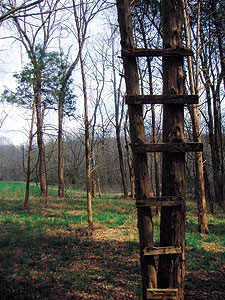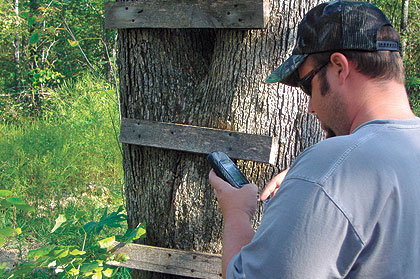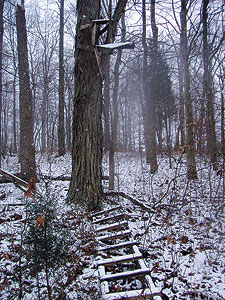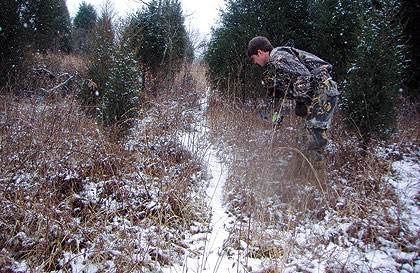October 28, 2010
By G. T. Howell
By G. T. Howell
 Unless major change, such as a new housing or commercial development has occurred, deer will generally continue traveling on many of the same routes they used in the past. Old dilapidated stands may just clue archery hunters into these timeworn travel routes. |
Although the lumber had faded close to a blue-gray color and a slight mist hung in the November air, the old perch shoddily nailed into a shagbark hickory 200 yards from my vantage point could still be easily discerned as a tree stand. One sultry summer day, months before, I had almost effortlessly freed the rotted ladder away from the ancient platform for fear that someone may actually attempt to climb the stand and hurt themselves. Its obviousness was apparent to even an untrained eye from afar and I did not want any young explorers from the surrounding farms to take a tumble.
On that June morning I remember having shaken my head in disbelief; not only at the stand's ridiculously detectable and squatty positioning, but also its location. Eighty yards into the mature stand of mast trees behind the hickory looked like a stellar place to set up, but the small, brushy hillside in front of the stand that hung so forlornly in the humid summer air certainly did not resemble a hotspot for bowhunting.
Advertisement
However, as an impressive number of deer passed within spitting distance of the rickety assemblage of framing materials on that first prime November afternoon, I began to understand why the original stand had been erected. Buck after buck unassumingly cruised within feet of the old perch, casually picking honeysuckle and swinging their racks side-to-side while shaking the water free from their soaking gray coats. Having already filled my tags in early October, I sat for hours throughout the remainder of our long season observing the local whitetails through the black and white viewfinder of my camcorder.
I caught close to a dozen different bucks, many multiple times, standing almost directly underneath the platform while using the brushy hillside as a safe vantage point to scan the hayfield in the valley below for nervous does. When setting up the camera's tripod at the beginning of my quiet sits I did not focus the camcorder towards the lush green oats I had sowed weeks earlier, nor the narrow trail I had mowed through the saw briars following the first hard frost, but rather the aged stand that someone else had built long ago. This experience further rooted a belief that I have long held, but sometimes been slow to adopt: many old, decrepit stand sites are deserving of a second glance.
Advertisement
Days Gone By
Whenever I happen across an old stand nailed into the fork of an oak or, in the case of a hang-on, meshed into the bark of a yellow poplar, my mind immediately begins to conjure up visions of a man dressed in Trebark camouflage sitting in the stand with a steaming Thermos of coffee at foot, greeting a chilly sunrise in hopes of simply having the opportunity to catch a flash of antler floating through the woods before him. Resting on the hunter's lap may have been an old Bear compound and half dozen XX75's or possibly a Marlin 30-30 with the bluing worn off around the receiver from years of thumbing blunt-tipped cartridges into the magazine.
Men of this description are who I saw in the country stores on cold autumn days when I was far too young to hunt, and these were the men that occupied many of the tattered stands that I now discover strolling among the hills and hollows 20-plus years later. I cannot help but wonder what the past occupants of an old stand harvested, or simply saw, out of the shambles of cut pine throughout the seasons and many times my imagination runs wild in speculation whenever I come across a reminder of days gone by slowly decomposing overhead. However, following the initial excitement I have learned to take an objective view as to why someone took the time to chain a forgotten portable or stick-build a stand in a particular spot as opposed to somewhere else.
 Even if you do not plan on immediately setting up near an old stand, mark it on a map or in your GPS or aerial photo during scouting trips. By "connecting the dots" between the old stands you have marked, it may be possible to predict travel patterns and research new sites for blinds or stands. |
Whether it be a complete novice to whitetails or a seasoned veteran, no one puts forth the effort of creating a stand site without some sort of hunch or solid evidence that makes a spot appealing enough for them to spend hours of their time literally "hanging out" there. In most locales, there were far less deer around two or three decades ago than there are now, therefore, the consistent horn-taggers of yesteryear had to excel at choosing productive stand sites out of necessity.
Seasons were shorter, antlered bucks were sometimes the only legal quarry, and in the case of archery equipment, effective range was not quite as far. Hunting techniques, technology, and ideals change a great deal more from one generation to the next, but the same does not hold true for our white-rumped quarry. All of this usually leads me to believe that if a stand was good a decade or two ago when there were considerably less deer subjected to more individual pressure, then the immediate area will probably be worthy of my own investment of time at present.
Of course, this approach also has to take in other considerations. At the very minimum, the make-up of woods changes pretty drastically in most parts of whitetail habitat over the course of 15 or 20 years. Even if a parcel is not logged or disturbed at all, different types of undergrowth emerge, new mast trees in different locations reach maturity, and areas that may have once been a tangled mess of vegetation perfectly suited for bedding, die and break down from lack of sunlight as the canopy matures and thickens. This type of natural change is about the least concerning and subtle changes can be adjusted for by means of a little scouting.
On the other hand, in my neck of the woods, major transformation comes in the form of large vinyl rectangles, chain link fences, and children's swing sets. Subdivisions certainly change the landscape and disrupt certain patterns, but probably not as significantly as many hunters think. Just because a row of houses has sprouted on the other side of the fence does not mean the deer are going to abandon their old haunts and habits on your side of the woven wire. Sure, things are going to change and other prime stand sites may emerge, but the majority of well-placed stands are essentially timeless when hunted in a cautious and educated manner.
 Exactly what a stand is overlooking may not always be evident upon first inspection; however, at different times during the archery season the answer might suddenly surface. |
One of my very best friends grew up deer hunting on a large paper lease in Mississippi. We visit his camp down on the Big Black River regularly and his grandfather will attest that the exact same stand sites that produced when he was a young scrapper are also where the best luck is had at present day nearly half a century later. I am not a "sign hunter", never really have been. Shiny rubs oozing with sap and moist scrapes framing cloven hoof prints make my eyes bulge and brain swirl, but I have always been one to hunt either terrain features that consolidate movement or permanent food sources such as hard and soft mast trees.
Stand at the base of the next old stand you discover and look around. Nine times out of 10, a person with a few notches on their bow limb can figure out why someone placed a stand where they did. Is there a giant white oak nearby, a creek crossing scarred up by sharp hooves, subtle hillside shelf barely evident at ground level, or are the woods exceptionally narrow at that spot? Sometimes an old stand has the same effect as a giant, red "Stop" sign that makes you pause and notice a faint clue that might have been overlooked otherwise on our sometimes quick forays into the woods for scouting.
Find A Stand, Then What?
Suppose you gain permission or ink a lease to a new parcel of ground and find that there are some permanent stands around, but they are not aged or necessarily vacated. The pressure treated lumber may still be bright, a strong pull-up rope still hangs from the limbs, and a few branches with perfectly sawed ends are scattered beneath the tree. What to do? Hunt out of them even though you know the deer are well aware of the danger of walking past? Tear them down and risk hurting yourself in the process of doing so? Sometimes in the whitetail woods there are no clear answers. In this case I once again try to figure out why the stand is where it is and then make an assumption that may or may not be true.
The bad thing about permanent stands is, in fact, their permanence; they are always there. When the sun is steadily peeking over the gray horizon it oftentimes seems more logical and definitely easier to just climb up into Ol' Faithful nailed into the Triple Oak down by the creek instead of lugging in a climber and wandering around spooking deer off in the distance while trying to find that one tiny reflector pressed into a tree you marked two months ago. I've been guilty of it in the past; this is why I know it is true! Carefully laid out stand sites and entry/exit routes seem to take a backseat when time is at a premium. Ol' Faithful may have been a top producer during its inaugural season one or two years ago, but after a few days with swirling winds and visual confirmations, deer begin to hone in on these permanent perches.
With a long forgotten stand I am going to probably set up my climber or lock-on reasonably close, with a stand that has been used recently I take steps by widening my search to find the closest "next best thing." Some folks would say to stay as far away from the area because the deer have clued into the stand, but I work on the assumption of area bucks being so pre-occupied with avoiding the stand that had someone sitting in it three afternoons a week last fall, that they walk smack into the middle of my satellite position.
 Modern archery hunters have a much more luxurious existence than their predecessors of only a few short years ago. Lightweight climbing stands, trail cameras and compound bows that zip arrows well beyond 300 feet per second were unheard of in the early '80s, but the ability to decipher deer sign is independent of any of these technological advances. |
Suppose a recently used stand site, one that you have reason to believe has been over-hunted, was placed along a hillside shelf or near a worn fence crossing on a stretch of sagging barbed wire. Both of these places are still going to show use, and it may even be good to spend a morning in the stand if you trust someone else's carpentry, but I would bet that the deer will avoid these places at the first sign of human presence in the area because in the past they associated these spots with danger. In these instances I would search for, what I have referred to as "the next best thing." Maybe there is another shelf on the other side of the ridge top that has caught the diverted hoof traffic, or a lesser-known fence crossing (note: with permission and a little common sense, a new fence crossing can be fashioned) 80 or 100 yards away from the spoiled area.
Conclusion
Even as a youngster, I recognized the value of someone else's scouting, and thus doing so yielded me one of my most favorite bucks to date. Most of my early days of serious bowhunting took place on my Granny's farm that was comprised of one-half agricultural fields and one-half, what we Kentuckians call, heavily wooded "hills and hollers." Having roamed the farm my entire life, I had always paused at one particular ridge top where a logging road steadily dwindled away as it neared the edge of one of the steep hills. Not one, but two very old deer stands stood within 50 yards of one another at a certain point off to one side of the rutted old road. The most conspicuous one still hangs today, nearly completely engulfed by the tree it was locked to sometime long ago when pull tabs still adorned beer cans and James Bond was the only one with a mobile telephone.
Nonetheless, most of my hunting in those days was concentrated on the complete opposite end of the ridgeline; primarily because that seemed to be where I always encountered deer. One summer I decided that two stands in one hard to get to location must be worth investigating, so that fall I did not set foot within 300 yards of either stand or the old logging road they overlooked until it was cool enough for me to sneak in without working up a sweat.
The first November morning I could make the long drive to the farm, I did, and without even knowing exactly which tree to climb, I somehow found a high-limbed white oak that was within sight of the two old stands once the sun peaked over the horizon. That morning I saw what I described to my brother-in-law later that afternoon as, "the buck of my dreams." An eight pointer with G2's stretching well over one foot and main beams that swept back beyond his head, passed well within range while trailing a lone doe, but did not present any kind of suitable shot. The following morning, the old gray-muzzled monarch sauntered by with another girlfriend, only that time he rode back home with me. That was years ago, but the experience has programmed me to always take a closer look at old stands, no matter how ridiculously placed they may seem to be.
I know that if the archery hunters of days gone by put half as much time and effort into placing their stands as I do my own nowadays, then I would almost alway
s feel confident when setting up near one of their previously selected spots. Not all archers are so meticulous, but at the least, whoever sat with high hopes on the stand's inaugural morning or afternoon, did so for a reason of their own. Every stand has a past, and many old artifacts left standing still have a very promising future if the right individual is fortunate enough to put the pieces together and allow history to repeat itself.
